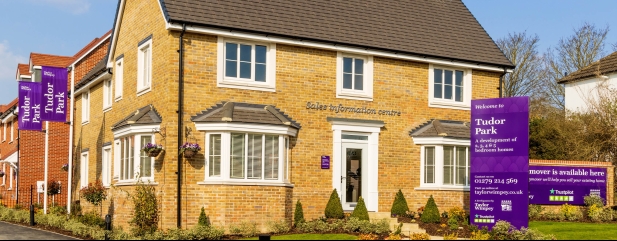Archived article
Please note that tax, investment, pension and ISA rules can change and the information and any views contained in this article may now be inaccurate.
Housebuilders: what’s holding back the sector and what could drive a recovery

Falling mortgage rates, a government eager to have more homes built, decent dividends and cheap equity valuations should, in theory, make housebuilders a big hit with investors.
Instead, we’ve got a sector where share prices are stuck in a rut. So, what will it take to get shares motoring again?
Fundamentally, we need new government incentives to fire up the property market, further interest rate cuts to improve mortgage affordability, and stronger consumer confidence. Two of those three factors are in motion, while the third is plausible.
SENSITIVE SECTOR
Shares in UK housebuilders are sensitive to interest rate expectations and economic activity. When sentiment is in their favour, these stocks can deliver supersized returns to investors. The opposite applies when there are economic or interest rate headwinds.
For example, shares in Taylor Wimpey (TW.) went up 85% between October 2014 and August 2015, fluctuated in a narrow range until May 2016, and then fell 43% over the following two months. Such levels of volatility mean housebuilders won’t suit all investors.
So far this year, the sector has lost 2.3% on average based on share price movements and dividends versus a 10.3% positive total return from the FTSE 100. At the top end, Crest Nicholson (CRST) has nearly matched the FTSE 100’s return whereas MJ Gleeson (GLE) has lost 26.4%.
MARKET CONCERNS
The market is worried about two key factors, while there are also company-specific factors which explain the divergence in fortunes.
Among investor concerns is the likelihood that first quarter 2025 sales were stronger than normal as individuals raced to beat changes to stamp duty. That implies that second quarter and potentially third quarter sales might be lacklustre across the sector.
Disappointing news on the volume of completions in Barratt Redrow’s (BTRW) latest update on 15 July, as well as significant charges relating to legacy building issues, haven’t helped sentiment.
Between September 2022 and the end of March 2025, buyers of homes in England and Northern Ireland worth less than £250,000 didn’t pay any stamp duty. First-time buyers paid no stamp duty on the first £425,000 when buying a home worth less than £625,000.
From 1 April, the rates changed whereby buyers pay 2% on values between £125,001 and £250,000 and the first-time buyer threshold has fallen to £300,000. Above these values, the tiered rate system is the same as before.
The prospect of paying thousands of pounds extra in stamp duty caused a rush of home buyers racing to complete purchases ahead of the April deadline. Certain people didn’t get their transaction over the line and there were reports of potential buyers pulling out of deals.
The other worry point for investors is the return of cost pressures. Extra employment related costs as a result of the chancellor’s Budget decisions in October 2024 have trickled through the supply chain, with companies supplying materials to housebuilders passing on those extra costs. Housebuilders themselves have also had stomach higher employment costs directly.
MJ Gleeson shares fell in June when it slashed profit forecasts, blaming a slower housing market, rising build costs and increased sales incentives. It also failed to sell a big block of land, thereby having less cash coming into the business than previously expected.
REASONS TO BE OPTIMISTIC
There is a reasonable chance that certain headwinds could fade away and tailwinds to move to the forefront as the year progresses.
The race to beat stamp duty is likely to have distorted near-term earnings for housebuilders, yet it should only be a temporary issue.
The market expects interest rates to fall from 4.25% to 3.5% by early 2026 and that would make mortgages much more affordable. It could be the catalyst to get more people on the housing ladder and drive transaction volumes among existing homeowners looking to move to a different property.
There are signs of optimism in pockets of the housebuilding industry among developers and suppliers. For example, Bellway (BWY) struck a confident tone in its June trading update, pointing to ‘good’ levels of customer demand. Brickmaker Ibstock (IBST) is planning to increase production capacity, citing signs of recovery in the UK housing market. Persimmon (PSN) is buying more land and gave an upbeat outlook in May.
The GfK Consumer Confidence index in June recorded its second consecutive monthly gain, driven by a more optimistic view of the economy. Consumer confidence is an important metric to track as buying a house is a big financial decision and people won’t commit if they are worried about their personal finances and job security.
The government has a target to build 1.5 million new homes by 2029. Key to achieving this target is reforming the planning system, removing red tap that slows down approval of infrastructure projects, and removing obstacles that have stalled new home developments.
While there remains uncertainty as to whether the government can achieve the goal, its policies still provide a tailwind for housebuilders to increase output.
The property market has been a priority for successive governments and this remains the case today. We’ve seen the Help to Buy scheme followed by the launch of the Lifetime ISA and various changes to stamp duty along the way, all designed to stimulate demand and facilitate access to the property market.
It’s natural to ask when we will get the next incentive, and there is chatter about a potential new equity loan scheme. One proposal from the Home Builders Federation bundles up a 5% deposit from the customer and a 15% equity loan from the government, including a 1% contribution from the developer.
On 15 July chancellor Rachel Reeves announced a shake-up of the mortgage market to enable more people to get on the housing ladder, potentially helping to stoke demand.
CHEAP VERSUS HISTORY
Valuations are not expensive across parts of the housebuilding sector relative to history. In boom times, it’s normal to see housebuilders trade on two times net asset value. Today, they trade at or below one-times.
Investing is all about taking a view on what might happen next, rather than looking in the rearview mirror. There is no guarantee that consumer confidence will continue to improve, inflation comes down, and the Bank of England cuts interest rates in the near-term.
However, it does feel as if the sector is looking more interesting and as a key industry in both the FTSE 100 and FTSE 250 indices, it could be worth keeping a closer eye on what housebuilders say from here, and what’s implied by key economic data points.
Important information:
These articles are provided by Shares magazine which is published by AJ Bell Media, a part of AJ Bell. Shares is not written by AJ Bell.
Shares is provided for your general information and use and is not a personal recommendation to invest. It is not intended to be relied upon by you in making or not making any investment decisions. The investments referred to in these articles will not be suitable for all investors. If in doubt please seek appropriate independent financial advice.
Investors acting on the information in these articles do so at their own risk and AJ Bell Media and its staff do not accept liability for losses suffered by investors as a result of their investment decisions.
Issue contents
Feature
Great Ideas
News
- Infrastructure group Galliford Try hits five-year high on raised guidance
- ‘Ugly’ update sends former ad giant WPP’s stock to 15-year low
- New tariffs threaten European, Canadian and Mexican trade with the US
- Lockheed Martin’s Q2 clues to US defence spending regime
- Bitcoin prices set record as investor bet big on ‘crypto week’
 magazine
magazine








